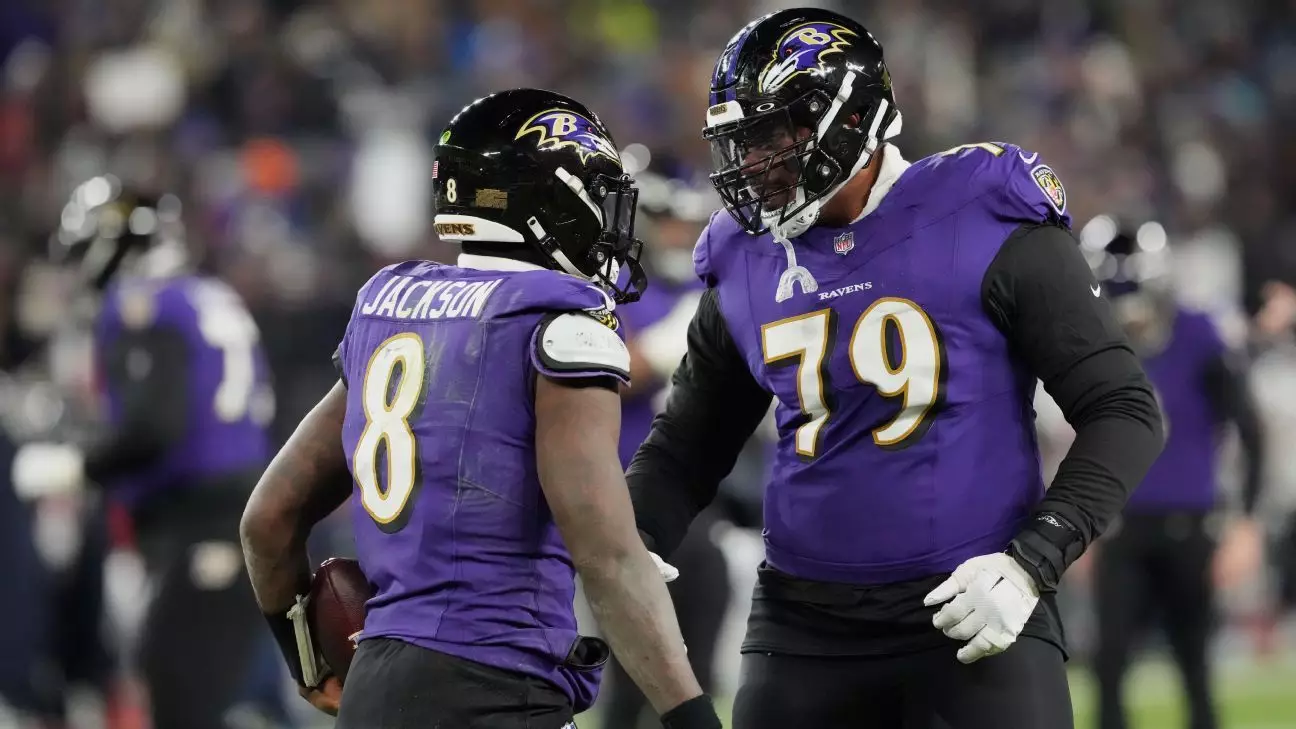The Baltimore Ravens are at a crossroads, grappling with crucial decisions regarding their offensive line as they head into the offseason. After a heart-wrenching playoff loss to the Buffalo Bills, where they fell short with a 27-25 score, the team’s left tackle, Ronnie Stanley, is a focal point for both fans and management. His future with the Ravens is steeped in uncertainty as he prepares to enter free agency for the first time in his career.
Stanley, who stood amid the somber atmosphere of a nearly deserted locker room following the playoff defeat, reflected on the emotional turmoil of the moment. “Who knows?” he said when pondering his future with the organization. This sentiment encapsulates not only his feelings but also the broader uncertainty surrounding the Ravens’ ambitions as they face the potential loss of one of their cornerstones. Stanley expressed that the defeat is likely the “toughest loss” he has endured, a sentiment that hits hard considering his tenure with the franchise since being drafted sixth overall nearly a decade ago.
For head coach John Harbaugh and general manager Eric DeCosta, the implications of Stanley’s potential departure weigh heavily. Having served as the starting left tackle since 2016, coupled with his Pro Bowl selections, his role has been pivotal in the protection of franchise quarterback Lamar Jackson. However, the Ravens have to evaluate their financial situation carefully, particularly as Stanley’s injury history and age come into play.
Financial Constraints and Market Dynamics
At the heart of the Ravens’ dilemma is the looming financial reality of the NFL salary cap. With Stanley projected to command an annual market value of over $20 million, retaining him becomes a complex equation for the Ravens, who are expected to rank among the bottom ten teams in cap space. This limitation forces them to consider whether they can meet Stanley’s financial demands while still investing in other crucial areas of need.
Last season, Stanley’s willingness to take a significant pay cut demonstrated his commitment to the Ravens, labeling Baltimore as his “second home.” This affinity complicates the negotiation dynamic, speckled with the possibility that he may opt to take less money to stay. However, the front office’s cautiousness—especially in light of his previous ankle injury that sidelined him for a substantial number of games—only intensifies the stakes.
If the Ravens fail to secure Stanley’s services, the prospect of moving right tackle Roger Rosengarten to the left side could be a feasible alternative. The Ravens selected Rosengarten in the second round of last year’s draft and he has shown the versatility to play both tackle positions. General Manager Eric DeCosta has acknowledged Rosengarten’s growth over his rookie season, suggesting that his adaptability could become an asset if Stanley departs.
The Ravens are no strangers to youth movement, as evidenced by their recent history of strategically replacing aging offensive linemen with younger talent. A bold shift took place last season when they replaced veterans Kevin Zeitler and Morgan Moses with younger options like Rosengarten and Daniel Faalele, a move that culminated in the Ravens achieving their best offensive performance to-date. This trend signals a willingness to innovate and adapt, even as the stakes escalate with every offseason decision.
The Ravens’ offensive line is a critical component of their overall strategy, especially given Jackson’s style of play, which often relies on a robust protection scheme. While they led the league in average rushing yards before first contact and racked up the third-fewest sacks last season, the loss of both Stanley and starting left guard Patrick Mekari—who also faces free agency—could disrupt the chemistry the unit has developed. The cohesion forged by last season’s younger line is essential for the Ravens’ offensive ambitions moving forward.
As DeCosta noted, the team made a difficult yet ultimately beneficial choice last year to prioritize youth as significant contributors along the line. The Ravens must now navigate the complexities of roster management while adhering to their vision of a forward-thinking franchise that balances nostalgia with innovation.
The Ravens face a pivotal offseason where decisions surrounding Ronnie Stanley could set the tone for future success. The intersection of emotional ties, financial constraints, and evolving team dynamics will undoubtedly shape Baltimore’s strategy as they work toward reclaiming their status as a Super Bowl contender.


Leave a Reply